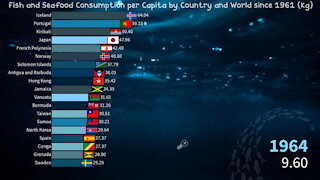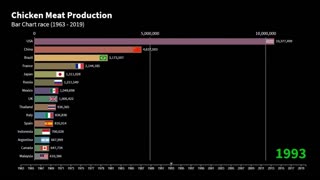BEEF Consumption per Capita by Country and World since 1961
This bar chart race shows the annual beef consumption per capita by country and world since 1961, measured in kilograms.
Since 1961, beef consumption per capita has played a significant role in the dietary habits and cultural traditions of various nations worldwide. Analyzing the statistics provided by the Food and Agriculture Organization (FAO), it is evident that beef consumption patterns have evolved significantly over the past six decades.
In the early 1960s, beef was a staple in many countries, especially those with strong agricultural traditions. Nations such as Argentina, Uruguay, and Australia witnessed substantial beef consumption, reflecting their historical association with cattle farming and meat production. Uruguay, and Argentina known for its vast pampas and gauchos, topped the charts of beef consumed per person in the 1960s.
As the world progressed, shifts in dietary preferences and socio-economic factors influenced beef consumption. In the 1970s and 1980s, rising incomes and globalization led to increased meat consumption across the globe. Countries like the United States, Brazil, and Canada experienced a surge in beef consumption, reflecting the growing affluence and changing dietary patterns of their populations.
By the 1990s, the narrative began to change. Concerns over health, environmental impacts, and animal welfare prompted shifts in consumer behavior. Consequently, some countries witnessed a decline in beef consumption. In Europe, for instance, several nations such as France, Germany, and the United Kingdom experienced a decline in beef consumption due to growing awareness of the potential health risks associated with excessive red meat intake.
Additionally, cultural and religious factors also played a role in shaping beef consumption patterns. In countries with significant Hindu and Muslim populations, such as India and Indonesia, respectively, beef consumption was relatively low due to religious restrictions. Conversely, countries with strong culinary traditions centered around beef, like Brazil and Argentina, maintained consistently high consumption levels throughout the years.
More recently, the focus on sustainability and climate change has further impacted beef consumption. Concerns over the environmental impact of livestock farming and its contribution to greenhouse gas emissions have led to an increased emphasis on alternative protein sources and the adoption of vegetarian and vegan diets. This shift in consumer consciousness has had varying effects on beef consumption across different countries.
In conclusion, beef consumption per capita has undergone substantial changes since 1961, influenced by factors such as economic development, cultural traditions, health awareness, and environmental concerns. While some countries have seen consistent high levels of beef consumption throughout the years, others have experienced fluctuations or declines due to changing dietary preferences and global trends. As we continue to navigate the challenges of the 21st century, the future of beef consumption will undoubtedly be shaped by emerging technologies, shifting consumer attitudes, and a growing focus on sustainability.
Music:
Imperss - Smooth Waves (Original Mix)
https://www.youtube.com/watch?v=qEFXXPA6AbM
Data visualization created with flourish.studio
-
 6:30
6:30
WhatDaStat
2 years ago🥕 Vegetable Consumption per Capita by Country and World since 1961
48 -
 4:50
4:50
WhatDaStat
2 years ago🐟 Fish and Seafood Consumption per Capita by Country and World since 1961
24 -
 0:59
0:59
Sambucha2
1 year agoCOUNTRIES THAT CONSUME THE MOST MEAT 🥩
1 -
 3:34
3:34
TheSecurinati
3 years agoChicken Meat Production Top Countries
13 -
 0:51
0:51
rethinkingthedollar
1 year agoAmerica's Beef Crisis: Prepare to Eat Less Meat
68 -
 0:58
0:58
jamesbigleyranches
1 year agoBeef in the United States, country of origin
2 -
 0:52
0:52
SWNS
1 year agoTwo-thirds of Americans are willing to eat meat grown in a lab
51 -
 0:58
0:58
jamesbigleyranches
11 months agoUnited States Cattle/ Beef
71 -
 1:37
1:37
Great Videos Now
6 months agoUnited Nations set to call on Americans to reduce meat consumption
51 -
 33:23
33:23
Holstein House
2 years agoGround Beef, Portion Control, and Inflation
20